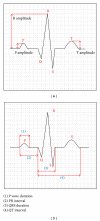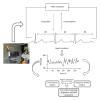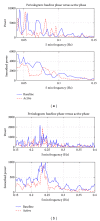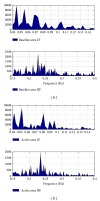Induced effects of transcranial magnetic stimulation on the autonomic nervous system and the cardiac rhythm
- PMID: 25136660
- PMCID: PMC4127210
- DOI: 10.1155/2014/349718
Induced effects of transcranial magnetic stimulation on the autonomic nervous system and the cardiac rhythm
Abstract
Several standard protocols based on repetitive transcranial magnetic stimulation (rTMS) have been employed for treatment of a variety of neurological disorders. Despite their advantages in patients that are retractable to medication, there is a lack of knowledge about the effects of rTMS on the autonomic nervous system that controls the cardiovascular system. Current understanding suggests that the shape of the so-called QRS complex together with the size of the different segments and intervals between the PQRST deflections of the heart could predict the nature of the different arrhythmias and ailments affecting the heart. This preliminary study involving 10 normal subjects from 20 to 30 years of age demonstrated that rTMS can induce changes in the heart rhythm. The autonomic activity that controls the cardiac rhythm was indeed altered by an rTMS session targeting the motor cortex using intensity below the subject's motor threshold and lasting no more than 5 minutes. The rTMS activation resulted in a reduction of the RR intervals (cardioacceleration) in most cases. Most of these cases also showed significant changes in the Poincare plot descriptor SD2 (long-term variability), the area under the low frequency (LF) power spectrum density curve, and the low frequency to high frequency (LF/HF) ratio. The RR intervals changed significantly in specific instants of time during rTMS activation showing either heart rate acceleration or heart rate deceleration.
Figures










References
-
- Kobayashi M, Pascual-Leone A. Transcranial magnetic stimulation in neurology. The Lancet Neurology. 2003;2(3):145–156. - PubMed
-
- Hallett M. Transcranial magnetic stimulation and the human brain. Nature. 2000;406(6792):147–150. - PubMed
-
- Rossini PM, Rossi S. Transcranial magnetic stimulation: diagnostic, therapeutic, and research potential. Neurology. 2007;68(7):484–488. - PubMed
-
- Udupa K, Sathyaprabha TN, Thirthalli J, Kishore KR, Raju TR, Gangadhar BN. Modulation of cardiac autonomic functions in patients with major depression treated with repetitive transcranial magnetic stimulation. Journal of Affective Disorders. 2007;104(1–3):231–236. - PubMed
Publication types
MeSH terms
LinkOut - more resources
Full Text Sources
Other Literature Sources
Medical
Research Materials
Miscellaneous

